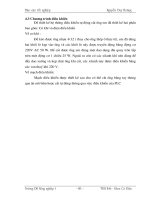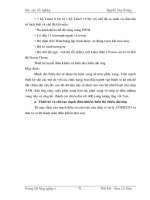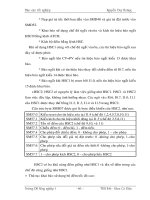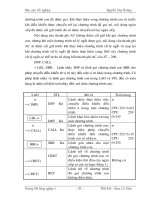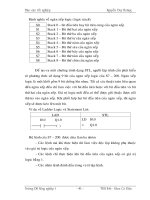Cấu tạo thép tòa nhà - P2
Bạn đang xem bản rút gọn của tài liệu. Xem và tải ngay bản đầy đủ của tài liệu tại đây (808.75 KB, 14 trang )
69
2.6.1 REINFORCEMENT COVERING
There are several reasons that necessitate the existence of covering for reinforce-
ment:
α. The protection of reinforcement from oxidation.
b. The need for adequate adhesion between the steel and the concrete.
c. The need for fire precaution. The reinforcement bars are protected by the con-
crete covering them from possible deformations caused in case of excessive
temperature development due to fire in the building,
d. The need to create cable channels without harming the reinforcement. It is very
common for an electrician or plumber to engrave channels in the frame in order to
integrate electric cables or pipes.
In general, when the covering of reinforcement is guaranteed by the use of special
plastic spacers, the cost is significant for the procurement, but very low for the im-
plementation of these spacers.
It is also possible to use ‘common’ materials for the creation of the covering, e.g
marble particles, that have no procurement cost but require a significant labor cost
for their implementation. What is more, the main drawback of using such materials is
the difficulty to be fitted properly since it should be implemented right after the instal-
lation of reinforcement and just before the concreting process.
In cases that we intent to leave the concrete visible, it is possible to use local or lin-
ear spacers made out of concrete reinforced with fibers or even use steel stands that
have edges made out of concrete reinforced with fibers.
Lower reinforcement covering of slabs
The minimum covering that should be provided for the reinforcement of slabs is:
In dry climates 2.0 cm
In seaside locations 3.0 cm
The covering is secured by the use of stands (called spacers) which are elements
neutral to oxidation. These elements are placed with approximately 1m spacing be-
tween each other.
Abstracts from the book of Apostolos Konstandinideis called ‘EARTHQUAKE RESISTANT BUILDINGS’, Volume A,
chapter 2.6, published in low resolution in the site of pi-SYSTEMS International S.A. www.pi.gr
70
The lower reinforcement covering of the above slab is secured by the use of plastic
spacers.
The simplest solution of securing the covering is that of the plastic spacers as illus-
trated in the above picture.
The usage of steel spacers is forbidden since it will almost definitely be oxidized.
When a steel rod is oxidized, it increases its volume and destroys the covering and
then the plaster, thus decreasing the actual life span of the building and endangering
the safety of the residents.
Abstracts from the book of Apostolos Konstandinideis called ‘EARTHQUAKE RESISTANT BUILDINGS’, Volume A,
chapter 2.6, published in low resolution in the site of pi-SYSTEMS International S.A. www.pi.gr
71
Securing the position of the upper reinforcement of slabs.
The upper (or negative) reinforcement of slabs, that either connects two slabs or one
slab and a cantilever, can only be properly secured with the use of specific spacers.
In the above example that the slab is connected with a cantilever, the position of the
upper reinforcement can be secured with the following techniques:
(α) Directly in the formwork, by using steel hystools.
(b) Indirectly, by using folded mesh spacers.
(c) Indirectly, by using S-type wire spacers.
Abstracts from the book of Apostolos Konstandinideis called ‘EARTHQUAKE RESISTANT BUILDINGS’, Volume A,
chapter 2.6, published in low resolution in the site of pi-SYSTEMS International S.A. www.pi.gr
72
Direct, steel hystool
Steel hystools are constructed by hard drawn
wire. Hystools have plastic coated feet in or-
der to eliminate any danger of rust staining in
the area that the spacer is supported by the
formwork.
Indirect, S-type wire spacers it is
available in the market in pre-cast
packages of straight wire. The S
formation is implemented during
the installation procedure.
Indirect, mesh spacers It is easily created
by folding the mesh in the required height.
The mesh is usually pre-fabricated and has
a specific density, e.g. Ǿ8/20. In cases of
cantilevers, apart from working as a spacer,
the mesh also satisfies the requirement for
‘hairpin bend’ reinforcement which secures
the cohesion of the cantilever edges. .
Abstracts from the book of Apostolos Konstandinideis called ‘EARTHQUAKE RESISTANT BUILDINGS’, Volume A,
chapter 2.6, published in low resolution in the site of pi-SYSTEMS International S.A. www.pi.gr
73
In cases that we use a mesh for the
upper reinforcement, we can secure
the position of the mesh by using an S-
type spacer placed upon the lower re-
inforcement, directly along the area of
the plastic spacer.
In cases that we use bended bars in
the upper support areas, the bending of
the bars will ensure that it will not move
from its position. Therefore, additional
indirect spacers may not be required.
Abstracts from the book of Apostolos Konstandinideis called ‘EARTHQUAKE RESISTANT BUILDINGS’, Volume A,
chapter 2.6, published in low resolution in the site of pi-SYSTEMS International S.A. www.pi.gr

